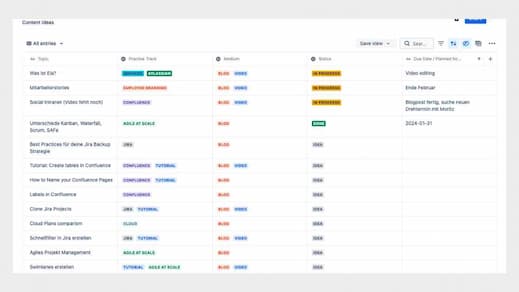4 min read
Jira Align OKRs: Achieving perfect alignment in an imperfect world
 Alma Dizdaric
:
Apr 28, 2022 9:45:00 AM
Alma Dizdaric
:
Apr 28, 2022 9:45:00 AM
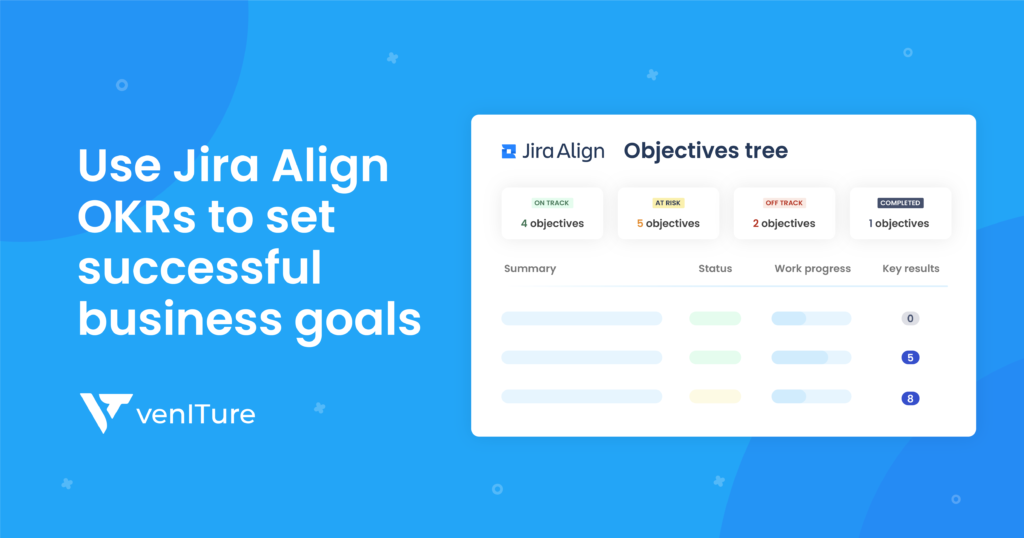
Objectives and Key Results (OKRs) is a collaborative goal-setting methodology used by teams and individuals to set challenging goals and focus their effort around the same important initiative(s). OKRs can help companies track progress and encourage engagement, but the core focus of OKRs is alignment.
What are OKRs?
“OKRs are clear vessels for leaders’ priorities and insights.” This quote comes straight from John Doerr’s Measure What Matters, which many business experts consider the handbook for OKRs and goal-setting.
In the simplest terms, companies set objectives and define key results that support the achievement of each objective and measure their impact. OKRs can communicate desired outcomes for the organization, prioritize areas for improvement, and deliver valuable business results.
OKRs are often confused with KPIs (Key Performance Indicators). While KPIs are metrics that reflect performance, OKRs is the goal-setting methodology used to improve performance and drive change. KPIs help you analyze the business to determine your OKRs, but they don’t provide insight into what needs to change or improve as OKRs do
Examples of OKRs include:
- Increase the number of qualified leads by X%
- Scale the QA engineering team
- Publish the product journey on Github
- Collect feedback from customers to evaluate the overall product experience (e.g. 100)
The purpose of OKRs is to decide what needs to be improved within your business. Based on those insights, how time and resources will be spent over the next quarter to make those improvements. Objectives reflect the areas that need to be focused on; key results measure how close you are to achieving that objective.
Why are OKRs effective?
While there are dozens of approaches to setting business goals, OKRs are by far the most powerful. The methodology is built on two highly effective goal-setting methods, SMART goals and Management by Objectives (MBO). At the same time, OKRs are designed to meet the needs of a fast-growing business and fast-paced work environment, making them perfectly suitable for Agile teams and environments.
Agile planning requires regular, planned cadences where the development progress is checked and evaluated against the enterprise environment and then made adjustments as needed.
OKRs consist of two parts: the qualitative objective defines what you want to do, and the quantitative key results define how you will know if you have achieved the objective. Evaluating whether or not you are achieving your objectives can help an organization decide whether or not to modify the path they are on.
How to work with OKRs
When you first establish your OKRs, it’s crucial to align your top-line OKRs with your organization’s mission, vision, and “north star” values. OKRs define what you would like to achieve and how to achieve them but should be guided by your overall vision and strategic roadmap.
It’s essential to create this alignment from the start and stay aligned throughout the quarter. Alignment can only be achieved if all OKRs support the same overarching goal. Whether you are a small start-up or a large enterprise, everyone within the organization has to move towards the same goal.
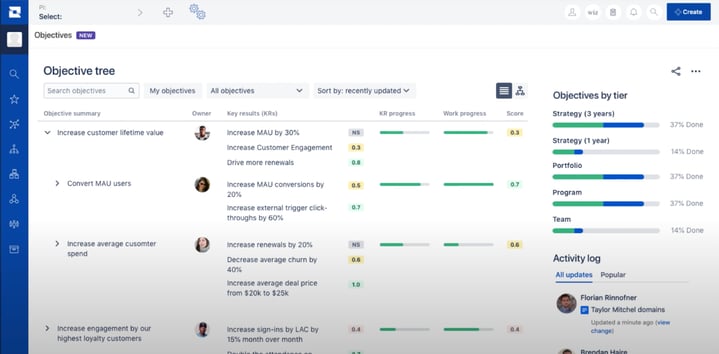
Image Credit: Atlassian
Aligning OKRs across teams and functions
OKRs should be rooted in alignment to maintain it. Start by contextualizing your OKRs as they relate to the overall company strategy. Then create subsets of a team or even individual OKRs, along with cross-functional OKRs. Companies using the SAFe (Scaled Agile Framework) should implement it across the various levels by defining, linking, and leveraging OKRs for the Portfolio, Program, and Feature Level.
Portfolio OKRs level
OKRs should be embedded in every portfolio epic and demonstrate how epics contribute to the overall strategic themes and investment objectives that the company has to assist with decision-making.
Program OKRs
The portfolio OKRs can inspire and steer the agile release train. The organization’s larger strategic goals should guide the portfolio OKRs. The Program OKRs should set the vision, provide context for the epics, and define features contributing to the defined objectives. OKRs should be set for high-priority initiatives to focus on the product management team.
Feature OKRs
Creating OKRs for each feature helps focus the team on the outcomes of each feature and adds discipline and structure. Once features are set for each level, meetings should be held at the team and executive level to discuss and review the OKRs to reflect priorities. Once everyone is aligned and in agreement, you can start executing.
Working with OKRs in Jira Align
Jira Align allows you to tie all of the work in progress to your OKRs, from themes to stories. Jira Align has supported OKRs for a while, but they’ve recently improved how OKRs are created, managed, and reported, making a single source of truth for your objectives. Jira’s OKR hub allows companies to easily introduce and manage OKRs and other objectives.
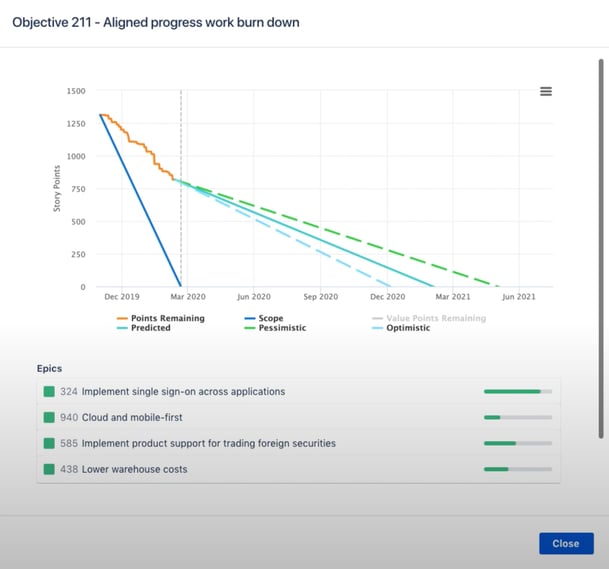
Image Credit: Atlassian
Setting up objectives
Jira Align’s OKR feature has a wizard-like, intuitive user interface where you can define objectives, add key results and align work. Set up the timeframe for your objective, the parent objective it aligns to, and how often you want to be reminded of the status of the key results via in-app notifications and reminders.
Add the key results
Provide your key results for each objective, the baseline percentage, the target date, owners, and measurable goals to obtain. Each objective can have its own owner.
Alignment
On the final screen, work is added to objectives. Because it can be challenging for employees at a team level to understand how their work impacts organizational objectives, Jira Align provides a visual representation. Therefore a clear association between assigned work and how those tasks roll up to the company’s goals is provided. This helps teams understand how their stories, features, epics, and work items affect their organization. With Jira Align, all work items from themes to stories can be aligned with the OKRs of the organization as a whole.
Tracking progress
Once your OKRs is set up in Jira Align, you are able to track the progress of your goals against your OKRs. The overall objective score provides two trackable progress bars. The key result progress that you update can yourself and the aligned work progress is automatically progresses as work is completed. From the Objectives Room, owners can check in on objectives, view the overall score, and drill down into the work done as a roll-up or by individual key results. They can also quickly assess impediments, view the activity logs, and update or override scores. Trends can be viewed in a highly visual chart format ideal for presentations.
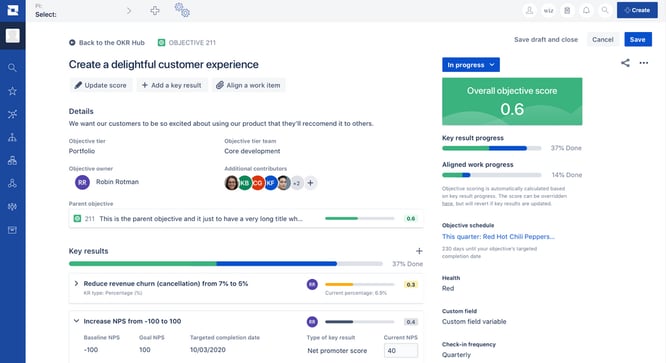
Source: Atlassian.com
In other words, Jira Align allows you to view and manage all OKRs from a single dashboard. You can also run objective reports to present to executives or managers during quarterly progress reviews.
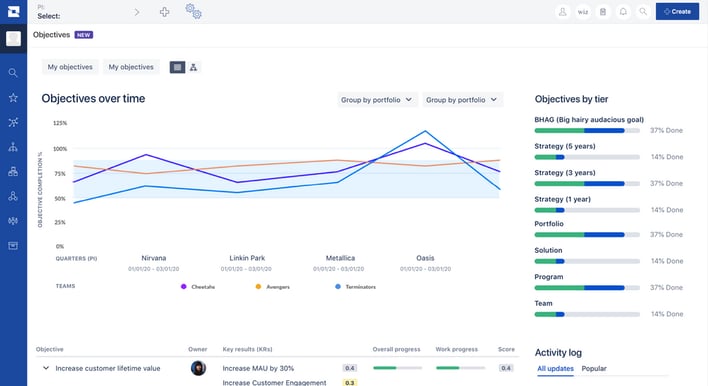
Source: Atlassian.com
The right tool to keep goals and results on track
Your organization can be compared to a rowboat. Unless every person onboard is rowing in the same direction, you’ll go completely off-course very quickly. OKRs provide the direction, but alignment is critical. Jira Align offers the right tools to continually evaluate and re-evaluate your key results and objectives and keep you on track.
The implementation of OKRs and securing that every level is aligned is a difficult task, which is why you need a trusted Atlassian partner like venITure on your side. Get in touch if you need help with your OKR implementation. We’re here to assist.
